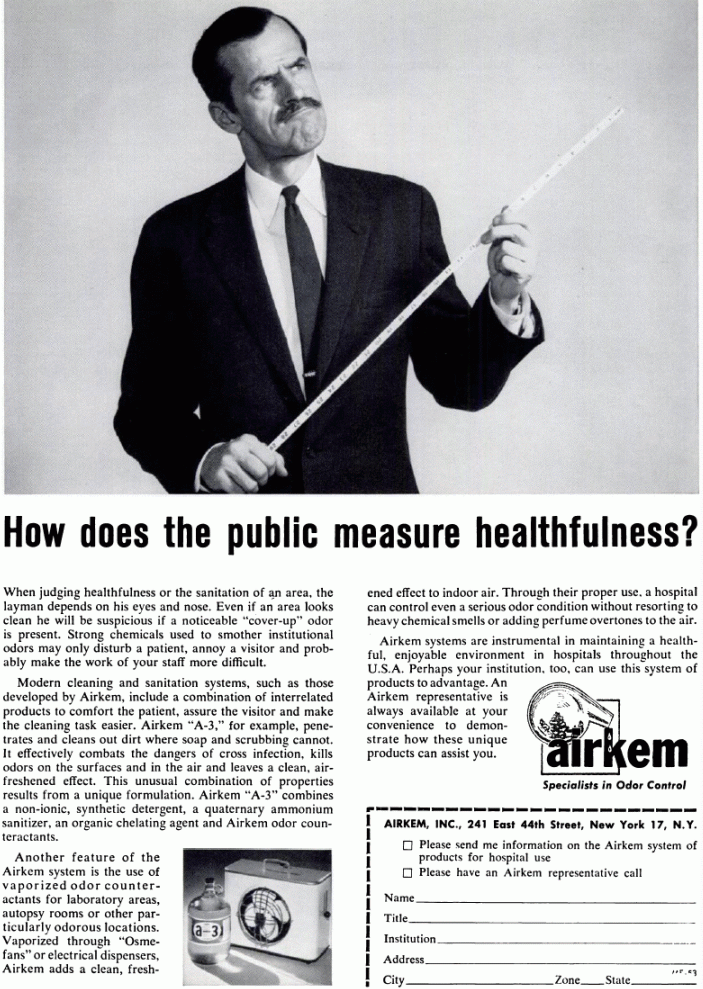

|
|
Airkem Odor Control advertisement, 1958. Mental Hospitals, Vol. 9, No. 5. How does the public measure healthfulness? When judging healthfulness or the sanitation of an area, the layman depends on his eyes and nose. Even if an area looks clean he will be suspicious if a noticeable "cover-up" odor is present. Strong chemicals used to smother institutional odors may only disturb a patient, annoy a visitor and probably make the work of your staff more difficult. Modern cleaning and sanitation systems, such as those developed by Airkem, include a combination of interrelated products to comfort the patient, assure the visitor and make the cleaning task easier. Airkem "A-3," for example, penetrates and cleans out dirt where soap and scrubbing cannot. It effectively combats the dangers of cross infection, kills odors on the surfaces and in the air and leaves a clean, air-freshened effect. This unusual combination of properties results from a unique formulation. Airkem "A-3" combines a non-ionic, synthetic detergent, a quaternary ammonium sanitizer, an organic chelating agent and Airkem odor counteractants. Another feature of the Airkem system is the use of vaporized odor counteractants for laboratory areas, autopsy rooms or other particularly odorous locations. Vaporized through "Osmefans" or electrical dispensers, Airkem adds a clean, freshened effect to indoor air. Through their proper use, a hospital can control even a serious odor condition without resorting to heavy chemical smells or adding perfume overtones to the air. Airkem systems are instrumental in maintaining a healthful, enjoyable environment in hospitals throughout the U.S.A. Perhaps your institution, too, can use this system of products to advantage. An Airkem representative is always available at your convenience to demonstrate how these unique products can assist you. Airkem ~ Specialists in Odor Control AIRKEM, INC., 241 East 44th Street, New York 17, N.Y. After from 2 to 8 months of training and observation each monkey was subjected to a series of acute motivational conflicts between hunger and fear. In effect, as the animal reached for its properly earned food reward, it was confronted instead with the head of a toy rubber snake extruding into the food box. After from 12 to 15 such "psychologically traumatic" experiences, the animals developed severe experimental neuroses variously characterized by hypersensitivity to nearly all stimuli, frequent startle and phobic reactions, inhibitions of feeding, play, and exploratory activities, chronic neuromuscular and organic dysfunctions, markedly increased homoerotism, masturbation, and other sexual deviations, hallucinatory and delusional patterns, and persistent alterations in social relationships parallel to those that occur in human neuroses and psychoses. These symptoms and their exacerbation or relief by various experimental procedures have been described in greater detail elsewhere; in our present report, we shall review briefly our special studies of the role of olfaction in the spontaneous, learned, and neurotic behavior of our animals. Masserman, JH, Pechtel, C. The Role of Olfaction in Normal and Neurotic Behavior in Animals. Psychosom Med 1953 Sep-Oct;15(5):396-404. This study was supported by a special grant from Airkem, Inc., New York. |